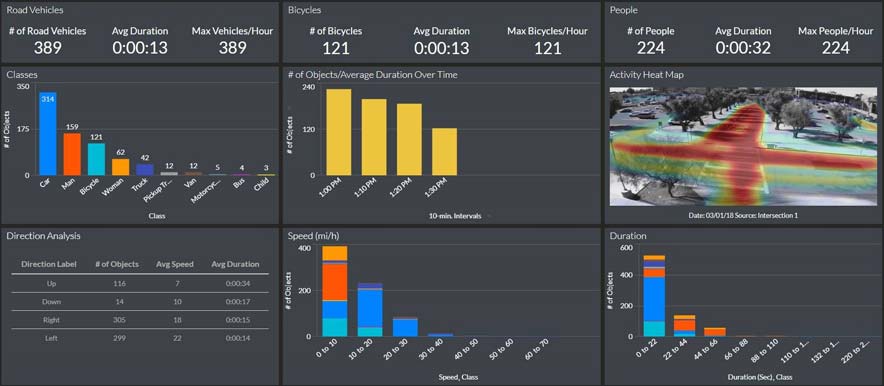Video Analytics: 10 Action Items to Prepare Your Campus for Installation
How many times have you heard stories of professionals in our industry who spent months or years planning a project, only to not get the most favorable, usable, and expected results?
The new generation of video analytics is an incredible force multiplier for campus security when coupled with human security and operations personnel. The data extracted from campus video surveillance systems can be used for real-time alerts and operational dashboards—including heat mapping and reports—to provide credibility to campus safety and operations decision makers.
University campuses are now using video analytics to alert decision makers to real-time threats and anomalies to enable them to act quicker, potentially preventing crimes from being completed. Real-time alerts provide rapid notification and evidence of vehicles traveling in the wrong direction, speeding through campus, and other unsafe events.
Universities are using traffic data and heat maps to make safety and construction decisions and plans for their campuses. A customer recently advised they were quoted $10,000 for a traffic count study at multiple intersections. Instead of spending the $10,000 and having the company lay cables across the roadway, which often get damaged and don’t provide as accurate and timely results, they will use their existing video analytics system to run this data as they need it.
Hospital security teams can review hours of video in just minutes to find events and suspects quickly in time-sensitive situations. They are using facial recognition to proactively alert security and operations personnel to unauthorized individuals at medicine cabinets and in pharmacy areas, as well as repeat persons for controlled substance abuse, high-risk patient tracking, contract tracing, and face mask detection for compliance enforcement. From ambulance bays, parking areas, pedestrian crosswalks into hospitals, waiting rooms, corridors, patient care floors, and cafeterias, video analytics are assisting hospital directors and executives in making decisions to provide safe, functional, and effective Environments of Care (EOC).

Corporate campuses are using facial recognition to provide real-time alerting of specific, unwanted persons entering their buildings, and dwell times to provide real-time alerts of loitering in parking lots and garages. Workplace violence mitigation and guidelines are rapidly becoming more scrutinized in the corporate campus environment.
Increases in employees returning to offices and getting back to work are picking up across the United States, and professionals are noticing that many of them are experiencing significant stress and negative emotions with the changes. This has them concerned. According to the Society for Human Resource Management (SHRM), more than 2 million U.S. workers annually file reports as a victim of workplace violence.
As security professionals, it is imperative to demonstrate our commitment to workplace violence prevention and mitigation, and video analytic technologies are a great component to these programs.
Useful technologies are advancing quickly for security practitioners’ benefit. The catch is that practitioners must prepare their base video surveillance system before implementing them.
Whether a university campus, a hospital campus, a corporate campus, or an airport, security practitioners must work with their consultants, integrators, and in-house personnel to take the following actions to have the most-actionable data and alerts:
- Identify or review preliminary safety and operational goals for your campus. Include specific behaviors and objects such as humans and vehicles that can affect those goals.
- Make a table for your existing cameras and future cameras.
- Group them into two groups: situational awareness cameras versus specific focus cameras.
Examples of situational awareness cameras include campus roadway cameras that may be used to monitor traffic congestion, building exterior cameras to gain situational awareness, and cameras that capture the flow of pedestrian traffic.
Examples of specific focus cameras include cameras at entrances and exits, medical cabinet and pharmacy areas, and other sensitive confined or chokepoint areas where faces may be more clearly captured. Specific focus cameras are also helpful for license plate recognition (LPR) at parking garage, gate, and campus entrances. - For each camera, define specific goals and associated target objects.
- Audit each camera through your Video Management System (VMS) at a minimum of three lighting times: morning sun, late afternoon sun, darkness. Identify any lightning improvements needed either through software adjustments, sunshields, external lighting, bulb changes, etc. Then, take corrective action to ensure that lighting and contrast allow for recognition and positioning of facial attributes, including the eyes, nose, and mouth.
- Audit each camera to determine vertical angle to objects, especially specific focus cameras. Ideally, cameras should be positioned at eye level for facial recognition and vehicle plate level for LPR. Realizing that is not usually practical, however, all effort should be taken to minimize the angle at less than 45 degrees to desired objects when possible. Make any necessary adjustments, which may entail relocating the cameras as needed, using pendant and mounting extensions, implementing protected poles or surface mounting, and extending cabling as necessary.
- Audit cameras through the VMS to determine the resolution and the associated pixels on target. For facial matching, you will want the face resolution to be more than 24 x 24 pixels across the face. Facial matching also performs best when the camera is less than 40 ft from the face and not surrounded by numerous other faces. For LPR, you typically will want a minimum of 60 to 80 pixels per foot. Make any necessary adjustments either by changing the focal view of the camera or upgrading the camera.
- Identify and plan to add any feasible additional cameras to meet your goals. For example, if you want to be able to determine occupancy levels, you will need cameras at each entry/exit in the defined occupancy area.
- Verify bandwidth from your cameras to your video management system (VMS), recording bit rate. When possible, set recorded frame rates to constant values greater than 7 frames per second. For busy, dark, or challenging scenes, work with your consultant or systems integrator to set higher bit rates and verify sufficient quality of video for target object types in the scenes.
- Verify the current version and release date of your VMS.
Taking the above steps before installing and implementing new and future generations of video analytic solutions will allow your security and operations systems operators and administrators to have higher accuracy and performance levels, which is critical to user experience and results during important decisions and critical events.
Rebecca Law, CPP is an eighteen-year security technology industry veteran. She earned an engineering degree from Georgia Institute of Technology, Summa Cum Laude, and has served the security industry in both the technology manufacturer and systems integrator capacities in system design, consultative sales, and leadership roles. Currently, she is the director of channel management with BriefCam®, a leading video analytics provider that delivers valuable insights for accelerating investigations, increasing situational awareness, and enhancing operational intelligence. You may share specific questions or stories with her at [email protected].
© Rebecca Law
